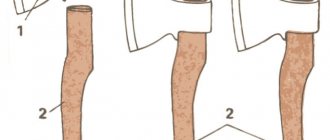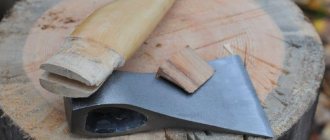Useful tips and tricks
Please note that the ax handle should be made so that its cross-section has a characteristic oval shape.
Only by observing this condition will you be able to successfully hold it without straining your hand too much. In this case, blows with an ax will be more accurate and easier. It is recommended to make wood blanks for creating an ax handle in late autumn. It is during this period that the movement of sap is reduced to a minimum (almost stops), which means that the tree becomes, as it were, dehydrated. Many inexperienced craftsmen neglect drying wood to build an axe. As a result, this ends up with the handle changing in size, and the metal part with the butt on it holds very poorly. It is permissible to use undried material only in special situations, when the handle needs to be built urgently, and this spare part is made as a temporary one.
When making a brand new ax handle yourself, you need to draw up a detailed drawing/template of the future tool. If you have a very convenient old ax in your arsenal, then you can remove all parameters from it. This will make it much easier and more convenient. Do not rush to turn the cutting edge of the tool. First you need to make sure the metal is sufficiently hard. If it turns out to be too soft, then it will need to be additionally hardened under the influence of high temperatures.
It is very important to use a ready-made ax (both homemade and store-bought) correctly. Experienced craftsmen strongly do not recommend trying to cut various metal parts with such a device.
Even if you plan to cut wood, it is better to make sure that there are no solid particles inside that could harm the tool.
It is strongly recommended not to throw the finished tool onto hard surfaces, especially from a great height. It is not recommended to leave the ax in the open air. Precipitation or aggressive sunlight can negatively affect the quality of the wooden part. Keep this tool in a dark and dry place. Only under this condition will the ax serve you for many years.
If the ax handle fits into the eye too easily, this may indicate that during the work the master made a serious mistake somewhere (most likely in the calculations). An incorrectly prepared template often leads to this problem. In such a situation, even one more installed wedge will not change anything
This is why it is so important to take your time to do all the calculations and make the template correctly
Do not forget to process the wooden ax handle at the end of all work. Please note that processing of this part must be carried out in several approaches. Each new protective layer should be applied only after the previous one has been completely absorbed. This is the only way to reliably protect wood from rotting and destruction. Stock up on enough wood to make an axe. You don’t need to make just one piece - it’s better to build several pieces. This is necessary because during the work some of them may not work out and be rejected. There should always be at least one more blank in stock.
To make an ax handle, you cannot use a wooden block that has a large number of knots. Because of them, noticeable cracks may form on the material. Over time, the branches begin to dry out, and the entire material loses its strength. Making an ax handle yourself is not at all difficult. If you doubt your abilities, are afraid of making a mistake and translating natural material, then it is better to refuse experiments. Buy a ready-made model or contact an experienced craftsman who will make a good tool for you.
To learn how to make an ax handle with your own hands, see the following video.
Photos of the best cleavers
Classification of axes
In practice, many types of axes are used, which are designed for working with wood. Conventionally, they can be divided into three types:
- cleavers;
- for logging;
- construction or universal.
Accordingly, there are various designs designed to solve specific problems, for example, a firefighter is equipped with a pick, with which you can pull beams and other structures away from the source of fire.
In addition to this classification, we can offer another one - according to the size of the blade, or more precisely, according to the size of the butt:
- wide;
- average;
- narrow.
The first ones are used in logging, the second ones solve many problems in construction and in everyday life, and the third ones have found their application in carpentry. These tools are also distinguished by the length of the ax handle. That is, the larger it is, the stronger the swing and, accordingly, the blow. There is a difference between the width and shape of the blade. That is, if the tool has a direct sharpening, then it is intended for chopping blows. If the cutting part has a curved sharpening, then it can both chop and cut.
Steel, wood, and polymer materials are used to make ax handles. But as experience shows, nothing better than a wooden (birch) handle has yet been invented. Other materials do not always cope with vibration damping.
The list of existing and widely used tools can be listed for quite a long time, the following can be mentioned:
- Tourist, it has small overall and weight characteristics, its weight is just over half a kilogram, and its length is 350 mm. With its help, you can prepare dead wood and perform simple work, for example, put together a ladder or a raft.
- Hunting. It is used for cutting dead wood and butchering harvested carcasses.
- Scandinavian. This tool is intended for professional woodcutters. It weighs 1.2 kg, with a length of 640 mm.
- Cleaver-sledgehammer. Its use allows you to split any log.
GOST 18578-89 normalizes the main dimensions of the product, maximum tolerances, and roughness parameters of the cutting part. According to the requirements of this document, each product must be marked. This GOST defines the procedure for acceptance and shipment of finished products to the consumer.
Made of plastic
Making a cover is not difficult if you use plastic that softens when heated. Many similar artificial materials have these properties. The easiest way to make a case is from plexiglass or polyvinyl chloride.
Required tools and materials:
- PVC pipe 100 mm, PVC or plexiglass sheet;
- hacksaw, saw, jigsaw;
- hair dryer, burner, metal bath.
Step-by-step manufacturing instructions
In the case of using sheet PVC, make a drawing of the cover as described above.
It is better to outline the ax along with the handle. It is necessary to leave a margin of 10-20 mm around the perimeter.
Then do this:
- Mark the place for the bend (a strip slightly larger than the width of the butt).
- Heat the sheet in the middle of this strip.
- Place the ax and bend the plastic.
- The place where the ends meet is heated well, one is wrapped and welded.
- It is processed with a file or “sandpaper”.
- A lid is made from plastic and placed on top or secured on small hinges.
The correct technology for sharpening an ax blade
The blade of a hand-made ax will perform its function only if the sharpening angle and chamfer width are maintained correctly.
The sharpening angle affects the convenience of the ax and the degree of its functionality. If you plan to cut damp, freshly cut wood, then the sharpening angle should be approximately 20°. If there are dry trees, then 25-30°.
The width of the chamfer is also very important, but an ordinary home craftsman cannot change it in ready-made blades purchased. However, there is a way out: sharpen the ax blade with a double “trigger.” The first angle is turned at 15°, the second at 25° (average value).
Sharpening an ax: a - sharpening angle, b - chamfer width (should exceed the thickness of the blade by 2.5-3 times)
The ax is sharpened using an electric sharpener. At the same time, make sure that the blade does not overheat too much - this leads to a deterioration in hardness near the cutting edge. Therefore, when starting the sharpening process, you should place a container of water next to the sharpener to cool the metal. It is advisable to immerse the blade in water after each pass along the circle.
It is necessary to reduce the runout of the grinding wheel to a minimum by regularly correcting it using special cutters. When sharpening, hold the ax so that the blade is directed towards the rotation of the electric sharpener. The butt is held at 45°. The blade is sharpened by smoothly moving the ax along the circle. The sharpening angle is carefully sharpened and the chamfer is polished.
Sharpening an ax on an electric sharpener allows you to quickly get a sharp blade
The final sharpening of the ax (grinding) is performed using a sharpening stone regularly moistened with water. Instead of a block, you can use a piece of plywood covered with sandpaper. Remember that working with a sharp ax is a pleasure, while a dull tool will force you to exert more effort, leading to rapid fatigue.
Assembly of the canvas
The blade and butt are connected by welding. It is important to weld the metal thoroughly so that the ax does not crack during operation.
Then we grind the seam with a grinder, if necessary, boil the shells, and grind again. For additional strength, you can rivet the butt and blade with strips of metal.
The importance of the handle
You can choose the optimal length of the ax based on the height of the master and the force of the blow. Strength, in turn, directly depends on the length, so when working with a large ax, it will be easier to chop logs of firewood.
Before making a choice, you should decide on the desired result:
- heavy version of the tool (total weight 1 kg - 1.4 kg, handle length from 55 to 65 cm);
- lightweight version (weight 0.8 kg-1 kg, with a length from 40 to 60 cm).
The quality of the wood from which the ax handle will be made is of great importance. Not every type of wood is suitable for manufacturing. Often, birch is used for these purposes (parts located near the roots or stem growths).
There are also handles made of oak, acacia, maple and other hardwoods. All selected workpieces require long-term drying.
After the wooden blank has dried well, the contours of the handle are drawn on it, according to a pre-made template. To avoid hand slipping during operation and to increase the convenience of the ax, it is necessary to provide a thickening at the end of the handle.
A knife, chisel, or electric jigsaw will help you cut out the outline.
After trying on the ax head and not finding any signs of a loose fit of the parts, you can safely continue improving the ax handle. Glass will help you scrape the tool, and sandpaper will be useful for grinding.
Story
The primitive hand ax-chop is often a stone pointed on one side and rounded on the other side.
Such a weapon (according to various estimates, it is from 800 thousand to 400 thousand years old) was at the same time an ax, a knife, and a pickaxe. The first axes with a handle appeared in the late (Upper) Paleolithic (35-12 thousand years ago). Axes were used for cutting trees and other work, similar to modern tools. Starting from the Neolithic, ground stone axes spread, then drilled ones. In the Chalcolithic, axes with copper blades began to appear. With the advent of bronze axes in the Bronze Age, stone axes continued to be used.
Sharpening the piercing part of the taiga ax
Excellent performance of the hatchet is ensured by a properly sharpened blade. The sharpening angle depends on the activity you will perform with the axe.
The taiga ax is sharpened at an angle of 30-35 ̊. If they will be working with fresh wood, then we sharpen it at an angle of 25 ̊.
If you use a sharpening wheel for sharpening, then the ax handle must be held at an angle of 40-45 ̊. We reproduce the sharpening slowly and carefully.
If you have all the necessary tools in stock, a photo of the step-by-step production of an ax, then its creation will not take a lot of time, effort and money, and in return you will receive a high-quality ax made by yourself.
But do not forget that with a piercing part made of high-quality metal, the ax will last much longer and if the handle is treated with linseed oil, it will not rot and deteriorate.
Nothing is impossible
Looking at the work of blacksmiths, the thought comes to mind that there is nothing difficult in making an ax. But in practice, this turns out to be much more difficult.
In addition to a piece of metal for forging an ax, you need: a forge, an anvil, holes for the eye. Not everyone has such a set of tools. Of course, you can make a forge and punches, but you can also try to make an ax in a different way.
Placing an ax on an ax handle
At first, such a procedure seems simple. This false impression is formed due to the simple connection of elements - mounting and wedging. However, the procedure is quite labor-intensive and has a number of subtleties that in no case should be ignored. To make this job easier, a professional and experienced carpenter always follows strict step-by-step instructions.
Preparatory work with the tool
First of all, you need to get an ax handle. You can buy it at any specialized store or make it yourself. The ideal material is pre-dried birch. Carpenters with extensive experience prefer wood of this particular species. It has the necessary set of properties and that is why it is so popular
When choosing a handle, it is recommended to pay attention to its density and shape. An important criterion is grip comfort.
If you do not take this point into account at the initial stage, your hands will experience discomfort while working with an ax, which will quickly lead to severe fatigue.
Next, you will need to purchase a handle of suitable dimensions that will fit tightly into the metal hole. Using a woodworking device or a sharp knife, it is necessary to trim the handle so that it acquires the required shape (straight or ellipsoidal). The ellipsoidal hole in the ax is considered more reliable due to its fastening. Small cuts are then made on the top surface of the handle. Visually they resemble longitudinal grooves.
The most important nuance at this stage is the depth of the grooves. The cut grooves should be hidden in the hole of the axe. Otherwise, during the wedging process or during use, the handle may simply crack. It is necessary to strive to ensure that the width and thickness of the wedges are the same.
Creating wedges
The reliability of fasteners is largely due to high-quality wedging. The use of wedges made of metal and wood will help with this. As in the case of an axe, wedges can be purchased in a specialized department of the store or made at home. An important condition is compliance with the shape and size between the wedges and the material used in the manufacture of the axe. The best wooden wedge, according to professional carpenters, is made from dried birch, and the best metal wedge is made from hard tin, the so-called shovel.
Hammering
Perhaps the main difficulty faced by everyone who decides to mount an ax on a handle themselves is driving in steel or wooden wedges. In fact, this process is not as complicated as it might seem at first glance. This stage can only be started after the handle and wedges have been completely prepared. To begin with, the longitudinal wedges are hammered in using light blows with a hammer. It is not worth making strong blows due to the fact that the wood may be deformed. And this can subsequently lead to instability of further fastenings.
Once the wedges fit snugly into the grooves, use a hacksaw blade to carefully cut off the remainder. You can verify the successful completion of the work by the strength of the grip of the ax and the handle.
Wedging
There is an opinion that a wooden wedge must be made from the same type of wood as the handle. However, this is a misconception. The main condition when choosing a material is its strength. In turn, the direction of the wood fiber should also be taken into account, since it is recommended to maintain parallelism in the narrowing of the wedges. This will protect the weapon from possible damage.
Successful wedging can be considered complete filling of the groove space with wedges, and removing the ax from the ax handle is considered impossible.
Sometimes it is still not possible to avoid gaps in the ax hole. Then an ordinary piece of gauze, which has been previously treated with epoxy resin, will come to the rescue. This composition allows you to provide wood with protection from moisture and impart reinforcing properties. To remove any gaps that have arisen before mounting the ax, its upper part is wrapped several times with treated gauze. Thanks to epoxy resin, any gap, crack or gap is filled, forming a reliable and strong attachment of the ax to the handle.
About cuts
Their location is the upper part of the shaft. The cut is a longitudinal groove into which the wedge will be inserted. Often, beginners, in addition to the question of how to attach an ax handle to an ax, are interested in how many cuts should there be in the handle? According to experienced craftsmen, you can limit yourself to one cut that stretches along the end. Judging by the reviews, this method of attachment is the most popular. Less commonly, the ax handle is equipped with one longitudinal and three or four additional ones on the sides. When making a cut, you should take into account its width and depth, which depend on the size of the wedges. They should not enter freely, since the whole point of wedging is lost. At the same time, it is undesirable for the wedges to fit into the cuts too tightly, otherwise the ax handle will simply split.
Alignment of the ax blade and the axis of symmetry of the ax handle
During the attachment process, we control the alignment of the ax blade and the axis of symmetry of the ax handle. In case of slight misalignment of the ax (misalignment of the blade and the axis of the eye), you can turn it slightly, choosing when attaching the ax on one side of the ax more than on the other.
Ax handle strength
Increased wear resistance of the handle is characterized by the strength of the original wood and the correct arrangement of fibers on the handle. The fibrous structure should be located along the ax handle - oblique layers will lead either to premature drying of the ax or to a break in the handle when chopping. The exception is curled workpieces; if you take into account the arrangement of the layers, you can achieve improved strength.
Preparing the template
When you have ready-made material, you can begin to create the ax itself. To do this, they think over and make a sketch of the handle, thanks to which the manufacturing process of the product in question is facilitated. The shape of the ax is determined by the type of tool. If a handle is required for a light ax weighing 0.8-1 kg, then its length is 0.4-0.6 m. The length of heavier ones can reach 0.6-0.9 m. Axes are classified according to their purpose:
- carpentry;
- lumberjacks;
- loppers;
- cleavers;
- butcher's
Based on the purpose of the tool, the length of the ax will depend. When making it, you should adhere to the following rules:
- to prevent the ax handle from slipping while working with an axe, the tail should be slightly wider than the handle itself;
- the cleaver's ax handle is made 0.75-0.95 m long, while for a carpenter's ax it is 0.5 m long;
- 10 cm is added to the length of the handle for allowance. This part is cut off after attaching the butt.
The future handle of the desired shape and size is drawn on cardboard, after which the image is transferred to wood and cut out with carpentry tools.
Wooden case
Some people make an ax case from scrap wood or thick plywood. This type of case can be seen in the fairy tale film “Three Fat Men” at the executioner.
It is an ordinary box in the shape of an axe. These are actually two halves on hinges.
Required tools and materials
- sheet of thick plywood 8-10 mm;
- wooden blocks 10×10 mm;
- glue;
- piano hinges or small door hinges;
- screws, small nails;
- jigsaw;
- hacksaw or saw;
- hammer.
The ax is placed on a sheet of plywood and outlined completely (along with the handle), adding 1.2-1.5 cm from each edge. Then they turn it over and outline the second side a little further away.
Next steps:
- Measure each line (for example, the top of an ax) and cut off bars of the appropriate size.
- After that, they are glued to one of the sides, screwed with screws or nailed.
- If the ax handle has an irregular shape, then its length is determined with a rope. It is applied along the handle along all bends. When the end of the ax is reached, a knot is tied or a mark is made with paint. The parts are cut out based on the size of the rope. To avoid mistakes, add another 2–3 cm. In this case, you need to use plywood to make the walls. It is soaked in water for about an hour or more, and then pulled or tied to the handle, wrapped with rope or tape over the entire surface. As it dries, it will take the desired shape. After this, it is strengthened on one of the sides of the future cover, and the unnecessary part is cut off.
- Screw or nail the hinges.
- The second side of the case is attached to them.
- One or two latches (clasps) are attached to the opposite wall.
How to choose the right wood for a handle
It’s curious, but not all tree species are suitable for making an axe. It is recommended to use only hardwood that has been previously dried in special chambers or kept in a dry place. Failure to comply with these requirements will lead to the fact that during use the handle will dry out and securely attaching the blade to the ax handle will be very problematic.
Home craftsmen use several types of wood to make wooden handles, each of which has its own advantages and disadvantages. Let's try to figure out which wood makes the best ax handle.
Birch
This is a “come and take” raw material, but the availability of the material does not guarantee high quality. To make a high-quality birch ax handle, the wood will have to be dried for 10-12 months. Even after this, the material remains sensitive to humid environments.
Maple
It is also an accessible and widespread material with a limited scope of application. In particular, maple handles are not suitable for making quality tools for a carpenter or lumberjack. However, the wood has a beautiful texture, making it ideal for decorative and souvenir wooden products.
Hickory
This unusual name hides an American walnut that grows in Canadian forests. For the manufacture of an ax handle, this is the best option, successfully combining strength, elasticity and durability. However, only American and Canadian loggers can truly appreciate these benefits.
Jatoba
This is a type of wood unique in its properties, which is used for the manufacture of sports equipment and furniture. Jatoba is easy to process and has a presentable appearance. At the same time, such solid wood is not inferior in strength to oak, so ax handles made from it are very reliable.
Ash
Among the listed options, ash is considered the optimal balance between availability and quality. At the same time, the wood has an interesting texture, so after appropriate processing, the wooden ax handle will have a presentable appearance without loss of strength and elasticity.
Important nuances
The strength and durability of the ax is determined by the resistance of the wood to dynamic shock loads. The reasons for premature breakage of the handle look like this:
- the use of soft wood reduces the service life of the ax by almost 2 times;
- poor drying - the blade landing site begins to become soaked;
- low density of the ax head - the blade walks along the surface, eventually breaking the handle.
It should be clarified that a properly made handle can last for several years without requiring repairs.
Selecting a workpiece and making an ax handle
The length of the ax is selected based on the height and strength of the master. The quality of the wood also plays an important role. Lightweight axes, weighing about 800-1000 g, have handles from 40 to 60 cm long. For heavy tools (1000-1400 g), the length of the ax varies from 55 to 65 cm.
Latest posts 5 unusual zucchini dishes instead of the boring pancakes and stews 8 folk remedies for fighting the Colorado potato beetle: for those who are against “chemicals” in the garden 5 ways to use garlic arrows, which experienced gardeners know
The force of the blow depends on the length of the axe. The longer the ax handle, the easier it is to chop wooden logs. The strength and height of a person also matters
Not every type of wood is suitable for making an ax handle. For this purpose, a true master searches the entire forest before finding a suitable tree. Most often, a blank for an ax handle is made from the root part of a birch tree, or better yet, from growths on its trunk, which are distinguished by their special twisted and very dense wood. Instead of birch, you can use maple, oak, acacia, ash and other hardwood deciduous trees. The workpieces must be dried well in natural conditions, which will take a lot of time.
On the prepared blank, the contours of the future ax handle are outlined according to the selected template. There should be a thickening at the end of the ax handle, designed to “braking” the hand in case the tool slips. Then the excess wood that is outside the contour is removed with a knife, an ax with a perfectly sharpened blade, a chisel or a jigsaw, which is much faster. After fitting the ax on the ax handle using a mallet, and making sure that these parts fit tightly, you can continue further finishing of the tool handle. Glass is used for scraping, and fine-grained sandpaper is used for grinding.
Above is a drawing of an ax handle (a) that meets the requirements of GOST 1400-73, and below is a marching ax handle (b) with an area of unbroken fibers of 40 mm
How to carve a toy ax
A homemade plywood ax can serve as an interesting toy for a child or be an excellent addition to a New Year’s costume. Often young children, teenagers and even adults want to make wooden axes, like in computer games like Minecraft. You can make such a product in 1.5-2 hours with minimal financial costs.
Making an ax from solid wood will take more time because the wood will be more difficult to process than plywood. The parts are cut out with a special cutter or a sharp knife, removing the chips layer by layer, ensuring that the dimensions and proportions are maintained.
With plywood everything is simpler. First you need to find a ready-made template or draw it yourself in full size. The drawing is transferred to a plywood sheet. The blade and handle are cut out separately with a jigsaw.
To make the wooden toy look more natural, it is better to glue the blade from two halves, after cutting a groove for the handle.
Then both halves of the plywood ax blade are placed on the handle, secured with pins and glued together with PVA glue for wood. After drying, the wooden blade is given a sharpening angle. This operation can be performed with an ordinary file. At the final stage, all surfaces are sanded and the blade is coated with several layers of silver paint. You can apply a custom design or stick a sticker. The finished wooden toy looks very beautiful.
Finishing
The assembled ax is carefully polished with fine sandpaper. The wood can be covered with stain or left as is. The protective layer is applied with oil or varnish.
For greater exclusivity, the ax handle can be decorated with carvings, inlays or wire notches. A pattern etched in a saline solution will look beautiful on the ax blade.
How to place an ax on an ax handle
The procedure for assembling an ax may seem simple, but this is only at first glance. To do it correctly, you need to know some nuances that are not recommended to be overlooked. Therefore, it is necessary to follow certain instructions.
Preparing the ax
After purchasing or making an ax handle, it needs to be adjusted to the ax hole. The handle under the eye is trimmed with a sharp knife, achieving a straight or ellipsoidal shape. After this, cuts are made in the form of longitudinal grooves on the upper part of the handle.
The depth of the grooves should be such that they are hidden in the eye of the ax. Otherwise the ax handle may crack.
Making wedges
The reliability of the tool attachment is largely determined by the quality of wedging. The material for the wedges is wood or metal. These elements can be purchased or made yourself. Professional carpenters are of the opinion that the best wedge is the one made from dried birch. The metal element is made from a piece of a shovel.
Driving wedges
After preparing the ax and wedges, you can begin wedging. First, the longitudinal elements are driven in and light blows are applied with a hammer or the butt of another axe. There is no need to hit it hard, as the wood may become deformed. Then the transverse wedges are driven in. The protruding parts are carefully cut off with a hacksaw and make sure that the ax attachment is secure. The procedure can be considered successful if the handle cannot be removed from the ax and the groove space is completely filled with wedges.
It happens that it is not possible to completely get rid of the gaps. In this case, you can use regular gauze soaked in epoxy. To do this, the upper part of the ax handle is wrapped in soaked gauze before inserting the ax. Epoxy resin allows you to eliminate any gap or crack, thereby forming a reliable fixation of the ax.
Types of axes
There are several types of axes, and each has its own purpose. Professionals distinguish this tool by the width of the butt, which can be wide, medium and narrow. At the same time, some use it for universal work, others for cutting wood, and some varieties are used for neat carpentry work.
Main types of axes:
- cleavers;
- for felling forests;
- construction;
- tourist.
Within each of these groups, there are various tool options designed for narrow-profile or other special work.
https://youtube.com/watch?v=-iIORmEEV-s
Handle differences
An ax handle is the name given to an ax handle. There are many varieties of them, made from different materials. Plastic and metal items are not in widespread demand, and their practicality can be confidently questioned. The most common wooden components of the tool are capable of dampening inertial vibrations during operation.
Classification of axes by handle:
- Lumberjack When using this tool, you need to hold it with both hands. Although this ax can be used quite successfully to chop wood, its main purpose is to cut down trees.
- Woodcutter. The ax is widely used in household farming. It is suitable for some types of carpentry, chopping wood and cutting small trees and branches.
- A carpenter. It is used primarily for processing logs and various wood products. They can be used to chop wood and cut down small bushes. The handle allows you to comfortably use the tool with one or two hands.
- Central Russian This ax is designed to be grasped with both hands, usually equipped with a powerful, sharp blade, and is used for butchering animal carcasses. It is noteworthy that the second name of this instrument is the taiga ax. On long-distance expeditions, it is very convenient to cut clearings with its help.
- Ermak. It is of medium size, and the small handle, held with one hand, implies a stronger load when working with the tool. It is convenient to carry with you. It is used primarily for household needs and chopping wood.
- Sturdy. The small size allows you to take it with you on hiking trips. With its help, you can build a hut, trim small tree trunks, chop firewood, or cut up a hunting trophy.
There are a number of other varieties, but they are classified as professional, intended for special work that requires specific skills.
Special models
To solve certain problems, separate versions of axes have been created. Let's look at them.
For felling forest
Axes that are used for felling trees are usually the longest - the minimum length of the ax handle is 90 cm, and the weight of the tool reaches 3-3.5 kg. Such a long handle allows you to provide the necessary parameters of swing and impact force, due to which wood harvesting work is carried out faster. It should be noted that working with such an ax is quite difficult, because this activity involves a lot of physical effort for woodcutters.
For chopping meat
Axes with a fairly wide and perfectly straight blade are most suitable for chopping meat. It is usually sharpened at an angle that protects the cutting edge from rapid destruction due to constant contact with hard, hard bones. The handle of this ax is usually short and extends down towards the cutting edge, which is why the device allows for very precise cutting blows.
Bilateral
Double-sided axes have found their use in cutting wooden blanks, preparing firewood and carrying out various installation works. The working part of such a tool has two blades; in most cases, they are made of forged steel using the double heat treatment method. The handle is made of hard wood, most often hazel.
Axes are widely used in the work of rescue services; in particular, firefighters use two types of axes - belt and assault. On the butt of the belt tool there is a rather sharp peg, which is necessary for knocking down locks and knocking out double-glazed windows. In addition, this hook can be driven into various surfaces to hold it in a wall or on a roof. Fire axes are typically painted black and red, although it is not uncommon to see yellow accents. The ax handle is covered with rubberized pads that protect your hands from burns. Unlike the belt models, the assault ones are much larger in size, but their shape is very similar.
They are used to knock down heavy doors and destroy any obstacles that might impede evacuation.
The butt often has a hook, or can be flat, like a sledgehammer. This type of weapon is a mandatory component of any fire shield, which, according to safety standards, must be located in all public places.
The tourist ax is called a multitool and has a wide variety of models. Their distinctive feature is their light weight, which is not surprising, given that the instrument has to be carried on your back for many hours. The handle of such an ax usually becomes a rather convenient storage for various small things that are necessary on any hike. With the help of a tourist ax, various branches are cut, small trees are felled, and even stones are split to create a fireplace. They are usually equipped with covers that protect a person from injury while carrying the instrument.
Ice axes are a separate type of tourist hatchets.
They are quite compact and lightweight devices, which are necessary for cutting into the thickness of the ice if climbing to snow-capped peaks takes place. This climbing equipment is made double-sided, with one part resembling a well-sharpened hook, and instead of a butt, there is a sharp blade placed perpendicular to the handle - this structure is optimal for forming a depression in the ice. An army ax can also come in handy on a hike. It is widely used to prepare logs for the fireplace, dig trenches, hammer in tent pegs, and also as a weapon of defense.
To learn how to choose the right axe, watch the video below.
Wood chopping
To prepare firewood, an ax is most often required in country houses and rural farmsteads, since even for frying barbecue, wood is the best fuel.
The blade of a wood ax is sharpened at an angle of about 40-60 degrees for better cutting.
The handle is most often made of wood, but can also be metal; the blade is made of hardened carbon steel
When asked which steel to choose, always pay attention to the manufacturer's seal mounted on the handle
The list of advantages of an ax can begin with the ease of working with it, since even a beginner can handle it. The second advantage is accessibility for the buyer in the sense that finding such an ax is as easy as shelling pears in any store.
There is also a wide price range for these axes, from which everyone will choose something for themselves.
The disadvantage of an ax of this format is that it is intended only for one type of work and cannot be used in other areas.
They cannot cut down a tree, and it is quite unsuitable for a butcher, since it is not so sharp. The disadvantages include the easy opportunity to get a low-quality fake, which the market is full of.
How to properly and permanently place an ax on an ax handle
Many of us are familiar with the situation when a perfectly mounted ax suddenly begins to jump off the ax handle. For few people this phenomenon is inexplicable.
Each of us understands that the drying process of wood is to blame.
But you should know that this can be completely avoided if the planting is carried out technologically correctly and if, after it is completed, you perform a couple of simple but very reliable actions. This is what I will tell you in order.
There are two sequential stages in this process:
- Selection and preparation of an axe.
- Actually planting the ax.
It is this logic that I will follow in my story.
Which side should I put the ax on? Many craftsmen know that the entrance eye of an ax is smaller than the exit eye. Why is this done? Yes, so that the ax handle can be wedged in it and securely fastened. Considering this fact, you should choose the right ax handle for a specific ax.
First you need to take the size of the outlet hole (the larger one) by outlining its internal contour on a piece of paper.
Then a template is cut out of paper along the drawn contour, on the basis of which the search for a suitable ax on the market will be carried out.
The selected ax should be given a couple of days for it to dry completely. To do this, you just need to put it on the heating radiator and occasionally turn it over there.
Do you want to know how to arrange your workshop so that it is very convenient to work in it? Then read this article by my colleague!
Impaling an ax
Mounting the ax begins by placing it on the edge of the ax handle, 5-7 millimeters from its edge, and then marking the boundary of the part that will be processed, i.e. planting boundary.
- Then the outline of the template must be transferred to the end of the ax handle.
- Having completed the markings and armed with a large wood rasp, process the end of the ax up to the boundary mark so that at the end it reaches the outline of the template.
- The end of the workpiece should ultimately coincide with the contour applied to it.
After this, you can begin to try on. Moreover, you need to try it on at the exit (large) hole of the ax. If necessary, you should sharpen it further. Processing should be completed when the ax begins to slightly “bite” the wood of the ax handle.
Having achieved such a “biting”, the very edge of the piece of wood is sharpened so that it fits about 1 cm into the ax.
Do you know how to sharpen an axe? If not, then click here!
After this, you need to take a caliper and measure the size of the entrance hole of the ax.
By further processing, this size should be achieved on the ax handle in the area of the initially applied boundary mark. Moreover, processing is carried out along the entire perimeter of the workpiece so that it completely fits into the exit hole of the ax.
Further processing should result in the end of the piece of wood resembling a champagne cork with a thickening at the bottom.
As in the beginning, the workpiece is processed using a rasp.
Monitoring the dimensions of the workpiece to ensure they correspond to the dimensions of the ax holes should be constantly carried out using a caliper. Having achieved full compliance, a small chamfer is removed at the very edge of the ax to facilitate the process of inserting the workpiece into the ax.
- Having finished processing, make markings for two slots on the processed end.
- The marked cuts are made to a depth not reaching approximately 1 cm from the border of the ax mounting.
- Having inserted the sawn end of the ax into the entrance hole, they begin to tap on its opposite end in order to place the ax on a wooden workpiece.
Then 3 wedges are installed on the glue in the cuts: one large longitudinal and two wedges on the sides. Having inserted the wedges, the end of the ax should be processed to give it perfect evenness.
Now the ax is very securely attached to the ax handle. But if the ax is left in this state, then the wood will inevitably dry out, and the tool may become unusable.
Preparatory stage
Before attaching the ax handle to the axe, its handle should be treated. It is made from a rough wooden block, mainly from birch. Due to the fact that the metal working parts come in different sizes, shafts are sold a little larger than they should be. This was done to ensure that the ax handle did not dangle and that it fit tightly into the ax. You will have to reduce the diameter of the shaft yourself. The handle is trimmed with a knife or other woodworking tool. Next, using a pencil, mark the contours of the eyes, as well as the places where the wedges will be located. Eyelets can be straight or conical.
Then you need to measure the height of the shaft and mark on it the place to which the ax will be lowered. Afterwards, measure the depth of the cutouts on the handle into which the wedges will be inserted in the future. To make the shrinkage more reliable, these recesses must be smaller than the wedges themselves. Make cuts using a hacksaw for metal. After marking and cutting, the shaft itself is finished. At this stage, craftsmen use sandpaper. It doesn’t matter what grain size it will be. The fact is that rough work will be done with this tool, and then the section of wood will be covered with an ax. Due to this fact, the surface may remain rough. The main thing is not to remove too much.











